Business Law Report: English Legal System, Employees, and Disputes
VerifiedAdded on 2020/09/17
|20
|5742
|22
Report
AI Summary
This report provides a comprehensive overview of business law, focusing on the structure of the English legal system, sources of law, and the role of government in law-making. It delves into employee legal obligations, including occupational health and safety and workers' compensation, and examines the impact of employment and contract law on businesses. The report further explores operative legal solutions for business issues, alternative dispute resolution methods, and provides recommendations for resolving business conflicts. The report also provides an overview of the structure of English legal system, and the role of government in making law. The report discusses the importance of employee obligations, including occupational health and safety and workers' compensation, and the impact of employment and contract law on businesses. Finally, the report highlights the importance of operative legal solutions for business issues and alternative dispute resolution methods, along with recommendations for resolving business conflicts.

Paraphrase This Document
Need a fresh take? Get an instant paraphrase of this document with our AI Paraphraser
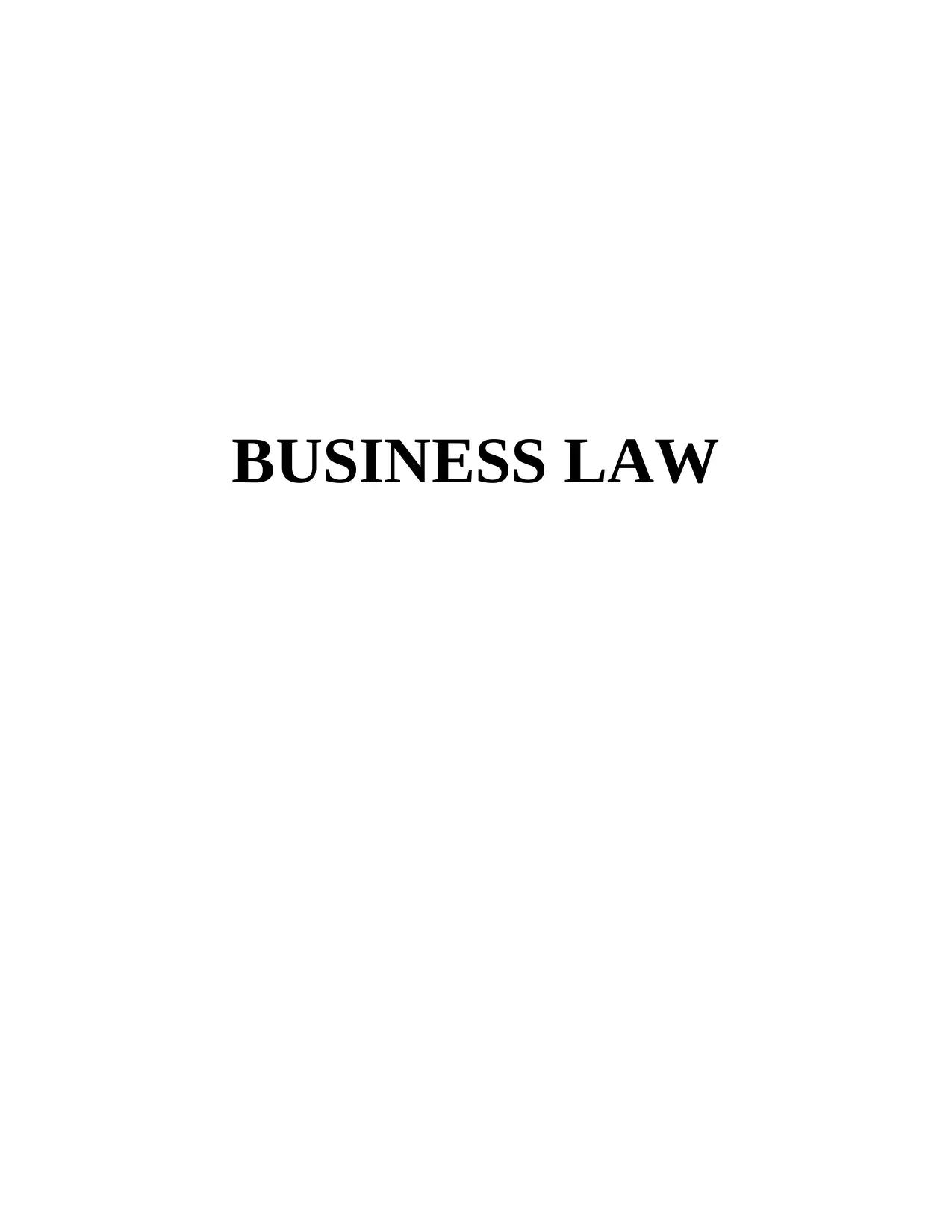
BUSINESS LAW
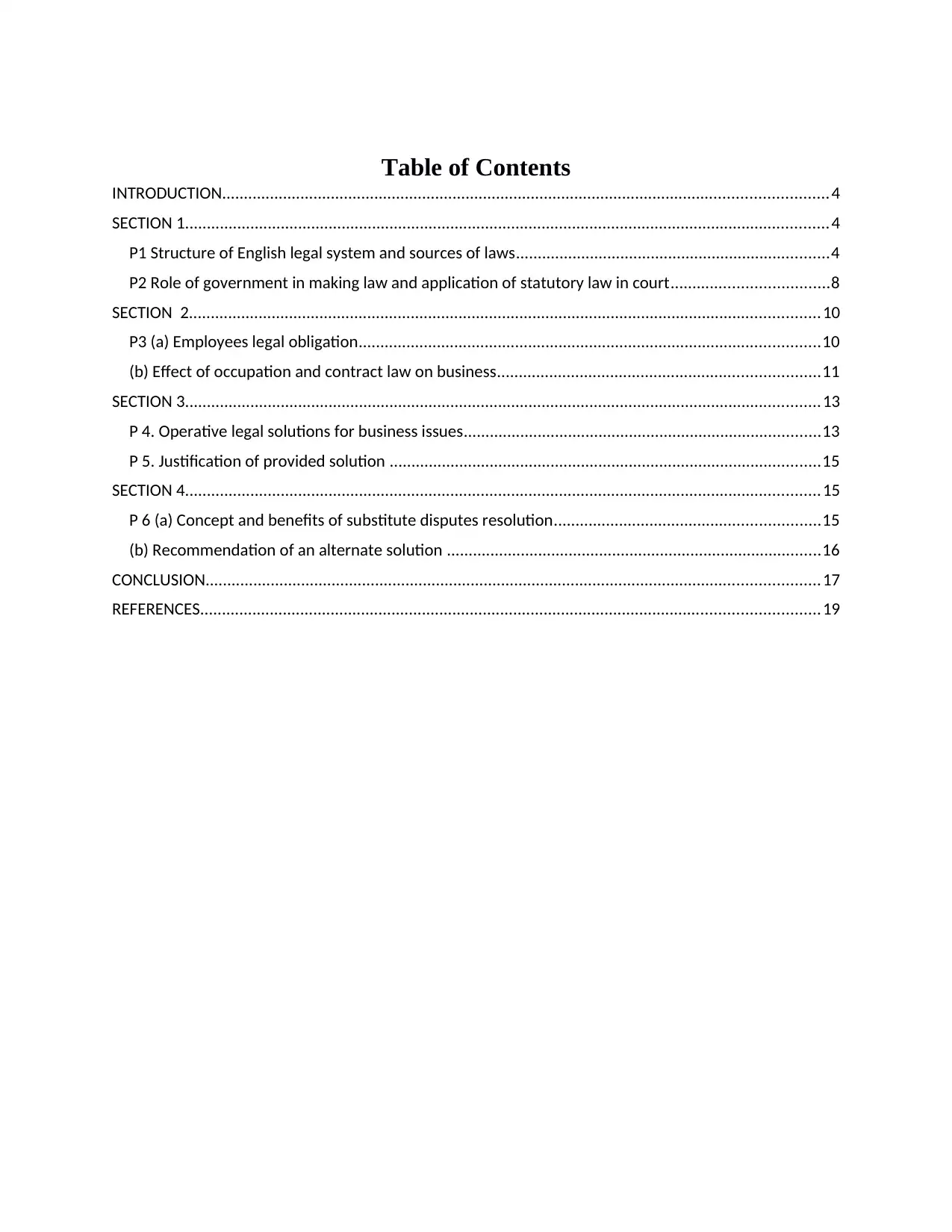
Table of Contents
INTRODUCTION...........................................................................................................................................4
SECTION 1....................................................................................................................................................4
P1 Structure of English legal system and sources of laws........................................................................4
P2 Role of government in making law and application of statutory law in court....................................8
SECTION 2.................................................................................................................................................10
P3 (a) Employees legal obligation..........................................................................................................10
(b) Effect of occupation and contract law on business..........................................................................11
SECTION 3..................................................................................................................................................13
P 4. Operative legal solutions for business issues..................................................................................13
P 5. Justification of provided solution ...................................................................................................15
SECTION 4..................................................................................................................................................15
P 6 (a) Concept and benefits of substitute disputes resolution.............................................................15
(b) Recommendation of an alternate solution ......................................................................................16
CONCLUSION.............................................................................................................................................17
REFERENCES..............................................................................................................................................19
INTRODUCTION...........................................................................................................................................4
SECTION 1....................................................................................................................................................4
P1 Structure of English legal system and sources of laws........................................................................4
P2 Role of government in making law and application of statutory law in court....................................8
SECTION 2.................................................................................................................................................10
P3 (a) Employees legal obligation..........................................................................................................10
(b) Effect of occupation and contract law on business..........................................................................11
SECTION 3..................................................................................................................................................13
P 4. Operative legal solutions for business issues..................................................................................13
P 5. Justification of provided solution ...................................................................................................15
SECTION 4..................................................................................................................................................15
P 6 (a) Concept and benefits of substitute disputes resolution.............................................................15
(b) Recommendation of an alternate solution ......................................................................................16
CONCLUSION.............................................................................................................................................17
REFERENCES..............................................................................................................................................19
⊘ This is a preview!⊘
Do you want full access?
Subscribe today to unlock all pages.

Trusted by 1+ million students worldwide
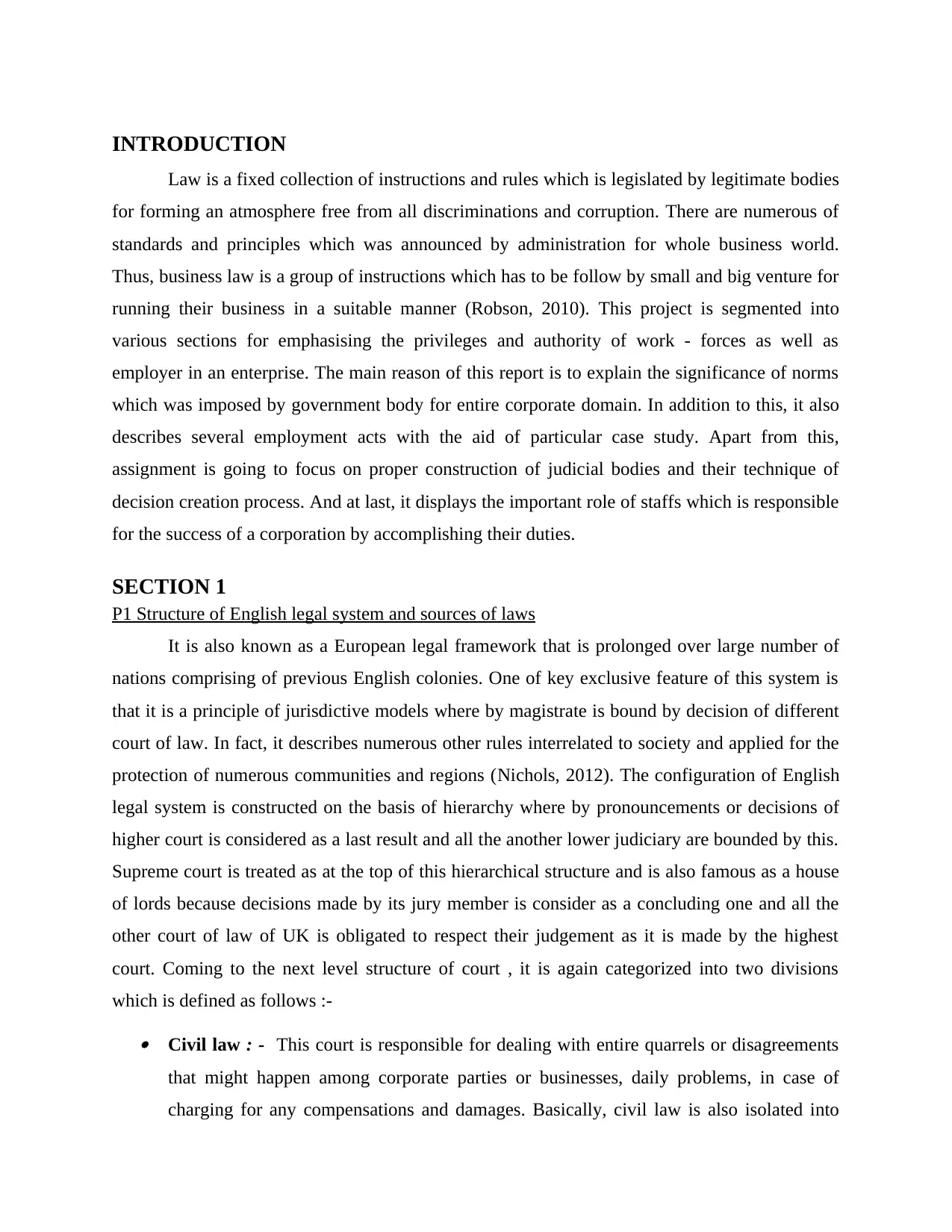
INTRODUCTION
Law is a fixed collection of instructions and rules which is legislated by legitimate bodies
for forming an atmosphere free from all discriminations and corruption. There are numerous of
standards and principles which was announced by administration for whole business world.
Thus, business law is a group of instructions which has to be follow by small and big venture for
running their business in a suitable manner (Robson, 2010). This project is segmented into
various sections for emphasising the privileges and authority of work - forces as well as
employer in an enterprise. The main reason of this report is to explain the significance of norms
which was imposed by government body for entire corporate domain. In addition to this, it also
describes several employment acts with the aid of particular case study. Apart from this,
assignment is going to focus on proper construction of judicial bodies and their technique of
decision creation process. And at last, it displays the important role of staffs which is responsible
for the success of a corporation by accomplishing their duties.
SECTION 1
P1 Structure of English legal system and sources of laws
It is also known as a European legal framework that is prolonged over large number of
nations comprising of previous English colonies. One of key exclusive feature of this system is
that it is a principle of jurisdictive models where by magistrate is bound by decision of different
court of law. In fact, it describes numerous other rules interrelated to society and applied for the
protection of numerous communities and regions (Nichols, 2012). The configuration of English
legal system is constructed on the basis of hierarchy where by pronouncements or decisions of
higher court is considered as a last result and all the another lower judiciary are bounded by this.
Supreme court is treated as at the top of this hierarchical structure and is also famous as a house
of lords because decisions made by its jury member is consider as a concluding one and all the
other court of law of UK is obligated to respect their judgement as it is made by the highest
court. Coming to the next level structure of court , it is again categorized into two divisions
which is defined as follows :- Civil law : - This court is responsible for dealing with entire quarrels or disagreements
that might happen among corporate parties or businesses, daily problems, in case of
charging for any compensations and damages. Basically, civil law is also isolated into
Law is a fixed collection of instructions and rules which is legislated by legitimate bodies
for forming an atmosphere free from all discriminations and corruption. There are numerous of
standards and principles which was announced by administration for whole business world.
Thus, business law is a group of instructions which has to be follow by small and big venture for
running their business in a suitable manner (Robson, 2010). This project is segmented into
various sections for emphasising the privileges and authority of work - forces as well as
employer in an enterprise. The main reason of this report is to explain the significance of norms
which was imposed by government body for entire corporate domain. In addition to this, it also
describes several employment acts with the aid of particular case study. Apart from this,
assignment is going to focus on proper construction of judicial bodies and their technique of
decision creation process. And at last, it displays the important role of staffs which is responsible
for the success of a corporation by accomplishing their duties.
SECTION 1
P1 Structure of English legal system and sources of laws
It is also known as a European legal framework that is prolonged over large number of
nations comprising of previous English colonies. One of key exclusive feature of this system is
that it is a principle of jurisdictive models where by magistrate is bound by decision of different
court of law. In fact, it describes numerous other rules interrelated to society and applied for the
protection of numerous communities and regions (Nichols, 2012). The configuration of English
legal system is constructed on the basis of hierarchy where by pronouncements or decisions of
higher court is considered as a last result and all the another lower judiciary are bounded by this.
Supreme court is treated as at the top of this hierarchical structure and is also famous as a house
of lords because decisions made by its jury member is consider as a concluding one and all the
other court of law of UK is obligated to respect their judgement as it is made by the highest
court. Coming to the next level structure of court , it is again categorized into two divisions
which is defined as follows :- Civil law : - This court is responsible for dealing with entire quarrels or disagreements
that might happen among corporate parties or businesses, daily problems, in case of
charging for any compensations and damages. Basically, civil law is also isolated into
Paraphrase This Document
Need a fresh take? Get an instant paraphrase of this document with our AI Paraphraser
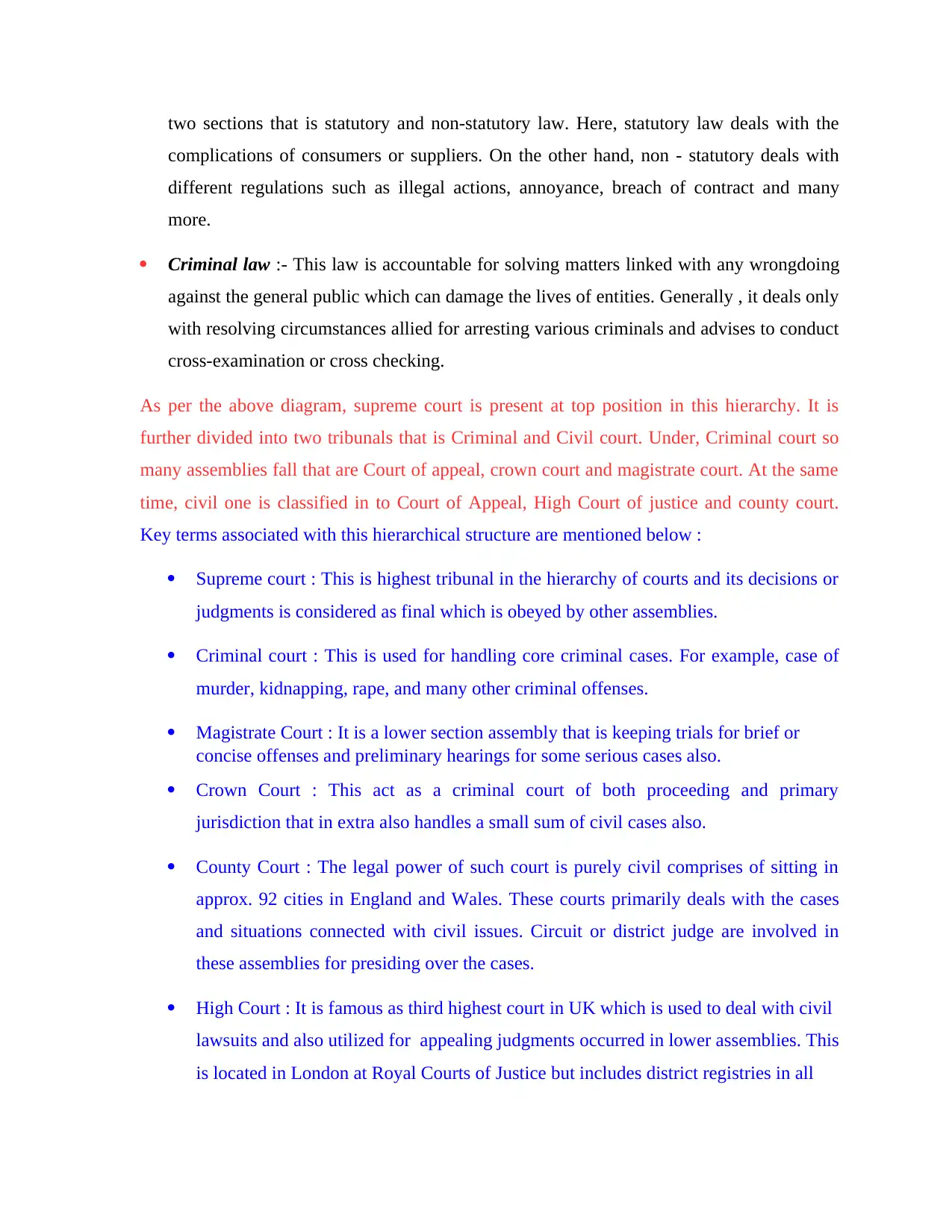
two sections that is statutory and non-statutory law. Here, statutory law deals with the
complications of consumers or suppliers. On the other hand, non - statutory deals with
different regulations such as illegal actions, annoyance, breach of contract and many
more.
Criminal law :- This law is accountable for solving matters linked with any wrongdoing
against the general public which can damage the lives of entities. Generally , it deals only
with resolving circumstances allied for arresting various criminals and advises to conduct
cross-examination or cross checking.
As per the above diagram, supreme court is present at top position in this hierarchy. It is
further divided into two tribunals that is Criminal and Civil court. Under, Criminal court so
many assemblies fall that are Court of appeal, crown court and magistrate court. At the same
time, civil one is classified in to Court of Appeal, High Court of justice and county court.
Key terms associated with this hierarchical structure are mentioned below :
Supreme court : This is highest tribunal in the hierarchy of courts and its decisions or
judgments is considered as final which is obeyed by other assemblies.
Criminal court : This is used for handling core criminal cases. For example, case of
murder, kidnapping, rape, and many other criminal offenses.
Magistrate Court : It is a lower section assembly that is keeping trials for brief or
concise offenses and preliminary hearings for some serious cases also.
Crown Court : This act as a criminal court of both proceeding and primary
jurisdiction that in extra also handles a small sum of civil cases also.
County Court : The legal power of such court is purely civil comprises of sitting in
approx. 92 cities in England and Wales. These courts primarily deals with the cases
and situations connected with civil issues. Circuit or district judge are involved in
these assemblies for presiding over the cases.
High Court : It is famous as third highest court in UK which is used to deal with civil
lawsuits and also utilized for appealing judgments occurred in lower assemblies. This
is located in London at Royal Courts of Justice but includes district registries in all
complications of consumers or suppliers. On the other hand, non - statutory deals with
different regulations such as illegal actions, annoyance, breach of contract and many
more.
Criminal law :- This law is accountable for solving matters linked with any wrongdoing
against the general public which can damage the lives of entities. Generally , it deals only
with resolving circumstances allied for arresting various criminals and advises to conduct
cross-examination or cross checking.
As per the above diagram, supreme court is present at top position in this hierarchy. It is
further divided into two tribunals that is Criminal and Civil court. Under, Criminal court so
many assemblies fall that are Court of appeal, crown court and magistrate court. At the same
time, civil one is classified in to Court of Appeal, High Court of justice and county court.
Key terms associated with this hierarchical structure are mentioned below :
Supreme court : This is highest tribunal in the hierarchy of courts and its decisions or
judgments is considered as final which is obeyed by other assemblies.
Criminal court : This is used for handling core criminal cases. For example, case of
murder, kidnapping, rape, and many other criminal offenses.
Magistrate Court : It is a lower section assembly that is keeping trials for brief or
concise offenses and preliminary hearings for some serious cases also.
Crown Court : This act as a criminal court of both proceeding and primary
jurisdiction that in extra also handles a small sum of civil cases also.
County Court : The legal power of such court is purely civil comprises of sitting in
approx. 92 cities in England and Wales. These courts primarily deals with the cases
and situations connected with civil issues. Circuit or district judge are involved in
these assemblies for presiding over the cases.
High Court : It is famous as third highest court in UK which is used to deal with civil
lawsuits and also utilized for appealing judgments occurred in lower assemblies. This
is located in London at Royal Courts of Justice but includes district registries in all
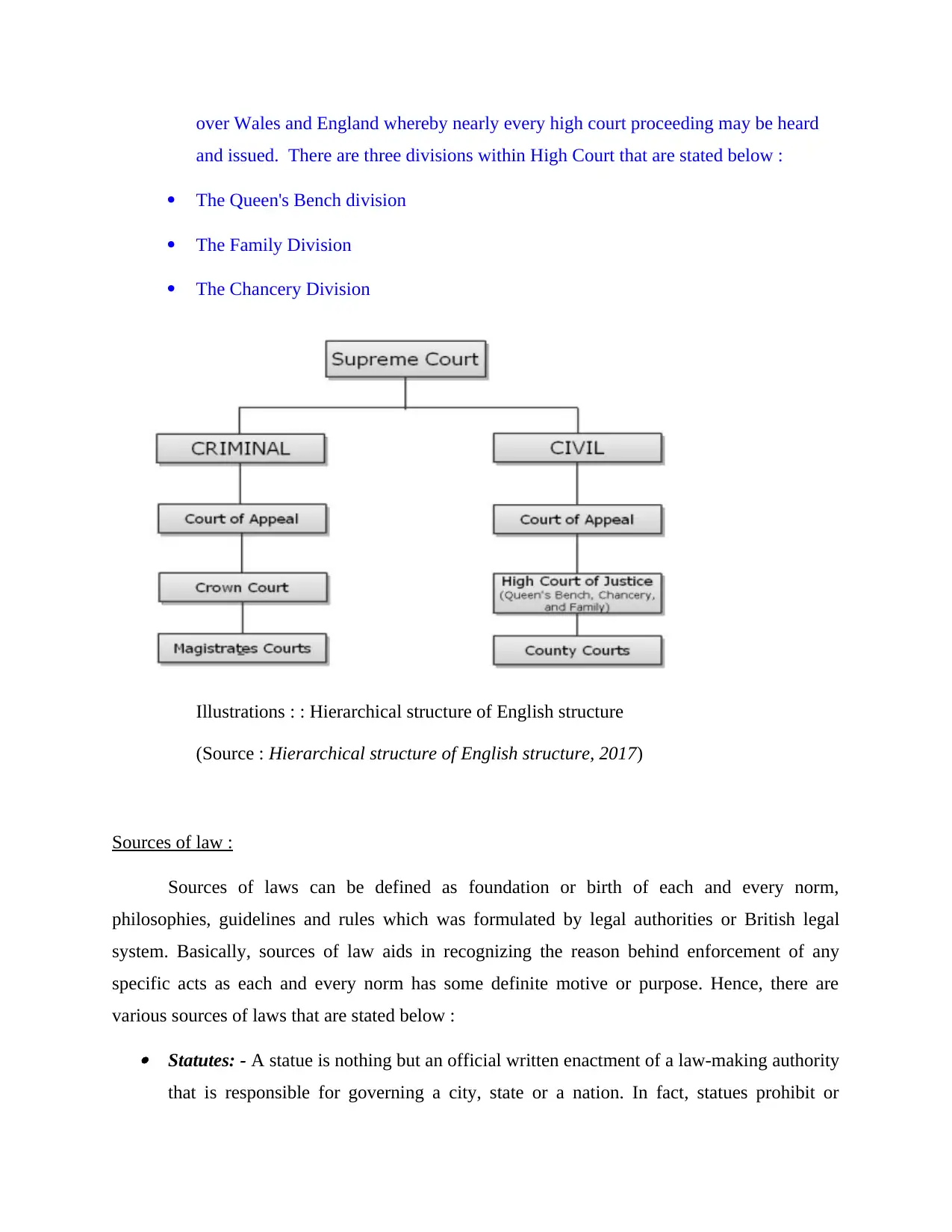
over Wales and England whereby nearly every high court proceeding may be heard
and issued. There are three divisions within High Court that are stated below :
The Queen's Bench division
The Family Division
The Chancery Division
Illustrations : : Hierarchical structure of English structure
(Source : Hierarchical structure of English structure, 2017)
Sources of law :
Sources of laws can be defined as foundation or birth of each and every norm,
philosophies, guidelines and rules which was formulated by legal authorities or British legal
system. Basically, sources of law aids in recognizing the reason behind enforcement of any
specific acts as each and every norm has some definite motive or purpose. Hence, there are
various sources of laws that are stated below : Statutes: - A statue is nothing but an official written enactment of a law-making authority
that is responsible for governing a city, state or a nation. In fact, statues prohibit or
and issued. There are three divisions within High Court that are stated below :
The Queen's Bench division
The Family Division
The Chancery Division
Illustrations : : Hierarchical structure of English structure
(Source : Hierarchical structure of English structure, 2017)
Sources of law :
Sources of laws can be defined as foundation or birth of each and every norm,
philosophies, guidelines and rules which was formulated by legal authorities or British legal
system. Basically, sources of law aids in recognizing the reason behind enforcement of any
specific acts as each and every norm has some definite motive or purpose. Hence, there are
various sources of laws that are stated below : Statutes: - A statue is nothing but an official written enactment of a law-making authority
that is responsible for governing a city, state or a nation. In fact, statues prohibit or
⊘ This is a preview!⊘
Do you want full access?
Subscribe today to unlock all pages.

Trusted by 1+ million students worldwide
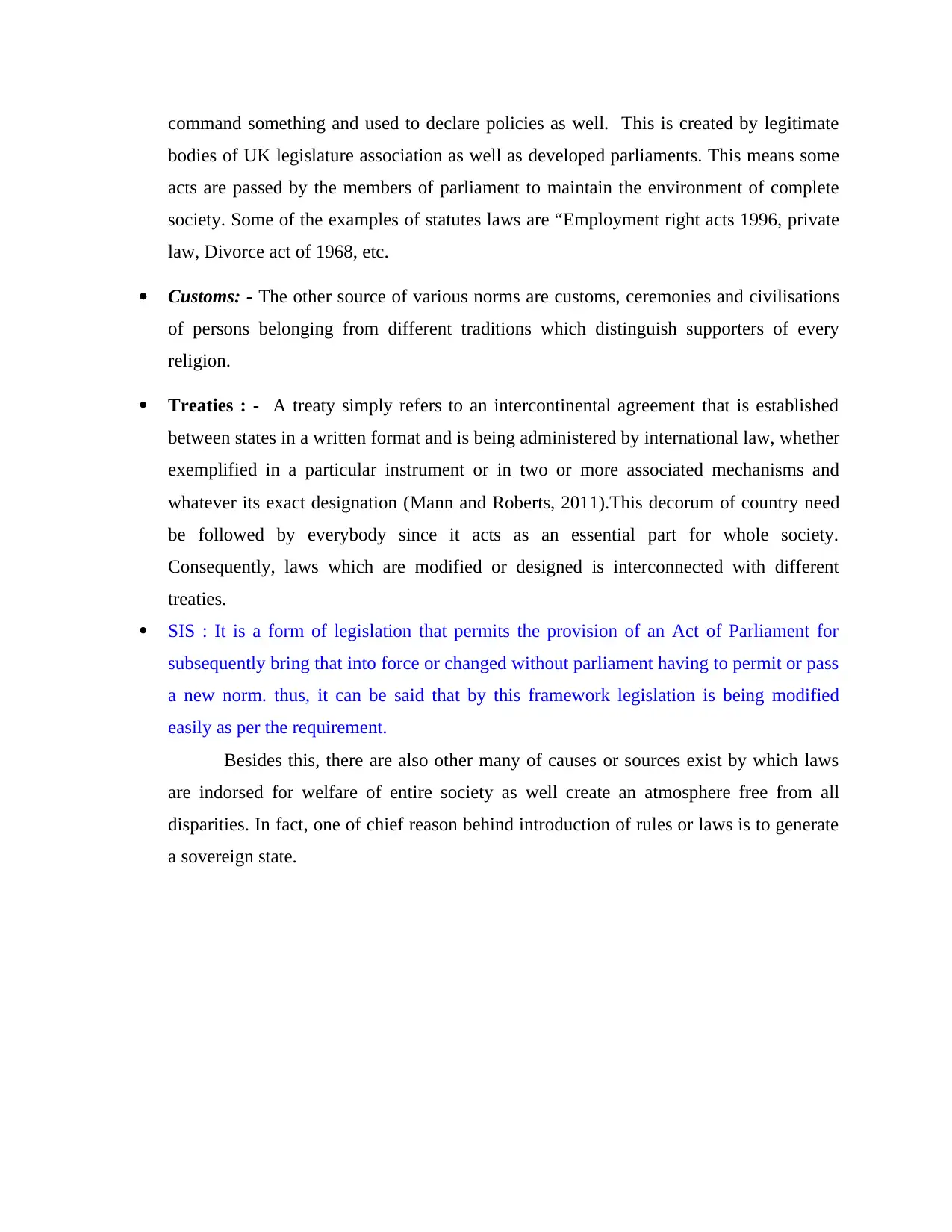
command something and used to declare policies as well. This is created by legitimate
bodies of UK legislature association as well as developed parliaments. This means some
acts are passed by the members of parliament to maintain the environment of complete
society. Some of the examples of statutes laws are “Employment right acts 1996, private
law, Divorce act of 1968, etc.
Customs: - The other source of various norms are customs, ceremonies and civilisations
of persons belonging from different traditions which distinguish supporters of every
religion.
Treaties : - A treaty simply refers to an intercontinental agreement that is established
between states in a written format and is being administered by international law, whether
exemplified in a particular instrument or in two or more associated mechanisms and
whatever its exact designation (Mann and Roberts, 2011).This decorum of country need
be followed by everybody since it acts as an essential part for whole society.
Consequently, laws which are modified or designed is interconnected with different
treaties.
SIS : It is a form of legislation that permits the provision of an Act of Parliament for
subsequently bring that into force or changed without parliament having to permit or pass
a new norm. thus, it can be said that by this framework legislation is being modified
easily as per the requirement.
Besides this, there are also other many of causes or sources exist by which laws
are indorsed for welfare of entire society as well create an atmosphere free from all
disparities. In fact, one of chief reason behind introduction of rules or laws is to generate
a sovereign state.
bodies of UK legislature association as well as developed parliaments. This means some
acts are passed by the members of parliament to maintain the environment of complete
society. Some of the examples of statutes laws are “Employment right acts 1996, private
law, Divorce act of 1968, etc.
Customs: - The other source of various norms are customs, ceremonies and civilisations
of persons belonging from different traditions which distinguish supporters of every
religion.
Treaties : - A treaty simply refers to an intercontinental agreement that is established
between states in a written format and is being administered by international law, whether
exemplified in a particular instrument or in two or more associated mechanisms and
whatever its exact designation (Mann and Roberts, 2011).This decorum of country need
be followed by everybody since it acts as an essential part for whole society.
Consequently, laws which are modified or designed is interconnected with different
treaties.
SIS : It is a form of legislation that permits the provision of an Act of Parliament for
subsequently bring that into force or changed without parliament having to permit or pass
a new norm. thus, it can be said that by this framework legislation is being modified
easily as per the requirement.
Besides this, there are also other many of causes or sources exist by which laws
are indorsed for welfare of entire society as well create an atmosphere free from all
disparities. In fact, one of chief reason behind introduction of rules or laws is to generate
a sovereign state.
Paraphrase This Document
Need a fresh take? Get an instant paraphrase of this document with our AI Paraphraser
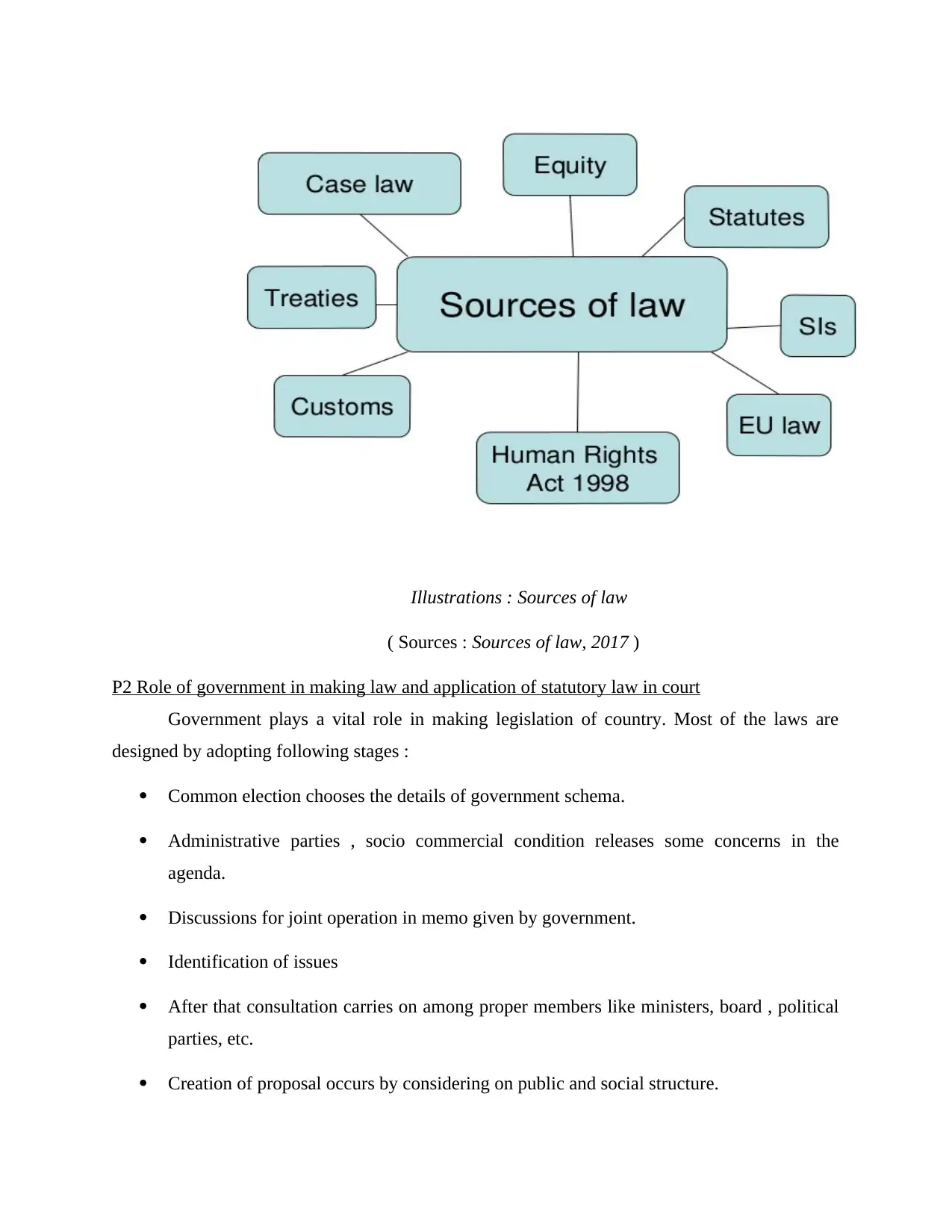
Illustrations : Sources of law
( Sources : Sources of law, 2017 )
P2 Role of government in making law and application of statutory law in court
Government plays a vital role in making legislation of country. Most of the laws are
designed by adopting following stages :
Common election chooses the details of government schema.
Administrative parties , socio commercial condition releases some concerns in the
agenda.
Discussions for joint operation in memo given by government.
Identification of issues
After that consultation carries on among proper members like ministers, board , political
parties, etc.
Creation of proposal occurs by considering on public and social structure.
( Sources : Sources of law, 2017 )
P2 Role of government in making law and application of statutory law in court
Government plays a vital role in making legislation of country. Most of the laws are
designed by adopting following stages :
Common election chooses the details of government schema.
Administrative parties , socio commercial condition releases some concerns in the
agenda.
Discussions for joint operation in memo given by government.
Identification of issues
After that consultation carries on among proper members like ministers, board , political
parties, etc.
Creation of proposal occurs by considering on public and social structure.
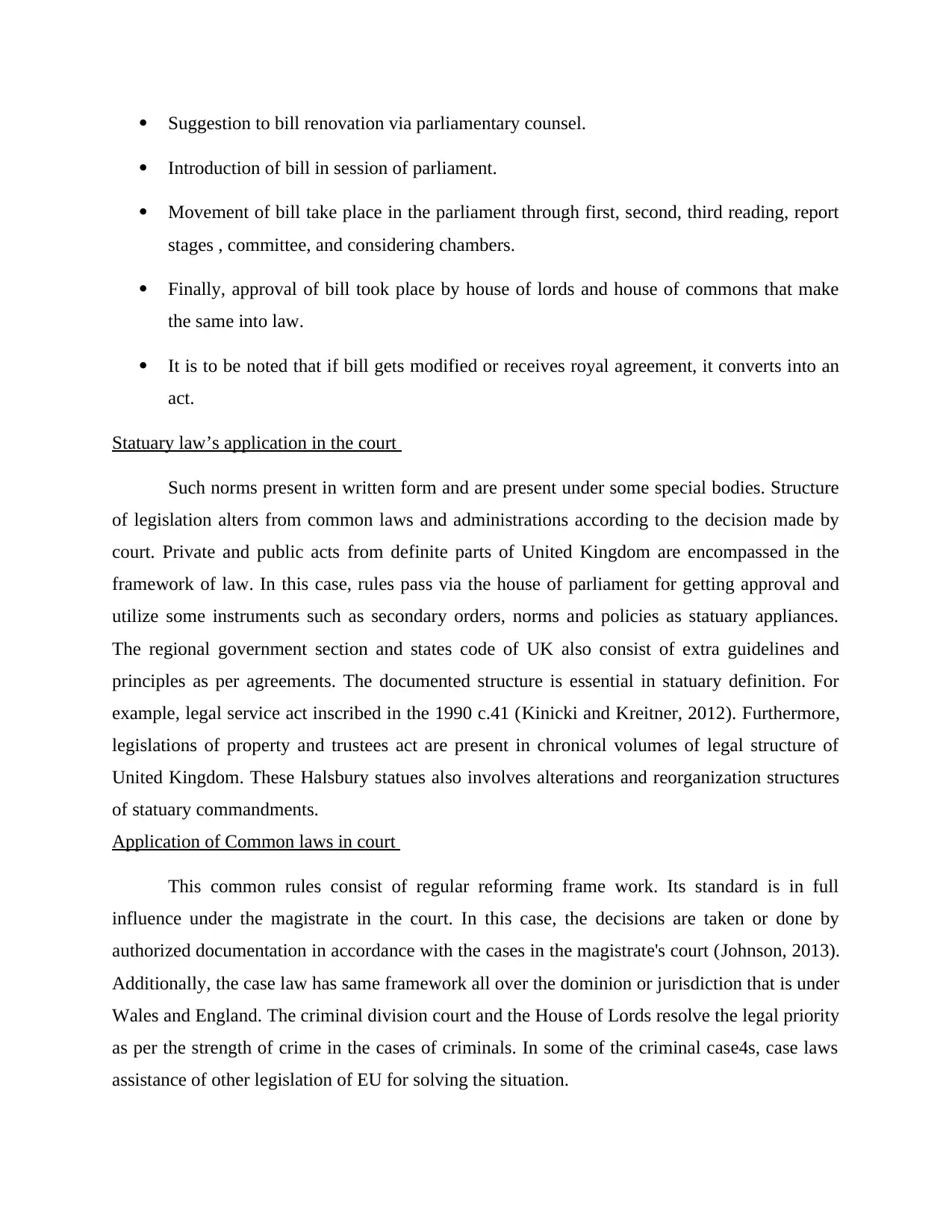
Suggestion to bill renovation via parliamentary counsel.
Introduction of bill in session of parliament.
Movement of bill take place in the parliament through first, second, third reading, report
stages , committee, and considering chambers.
Finally, approval of bill took place by house of lords and house of commons that make
the same into law.
It is to be noted that if bill gets modified or receives royal agreement, it converts into an
act.
Statuary law’s application in the court
Such norms present in written form and are present under some special bodies. Structure
of legislation alters from common laws and administrations according to the decision made by
court. Private and public acts from definite parts of United Kingdom are encompassed in the
framework of law. In this case, rules pass via the house of parliament for getting approval and
utilize some instruments such as secondary orders, norms and policies as statuary appliances.
The regional government section and states code of UK also consist of extra guidelines and
principles as per agreements. The documented structure is essential in statuary definition. For
example, legal service act inscribed in the 1990 c.41 (Kinicki and Kreitner, 2012). Furthermore,
legislations of property and trustees act are present in chronical volumes of legal structure of
United Kingdom. These Halsbury statues also involves alterations and reorganization structures
of statuary commandments.
Application of Common laws in court
This common rules consist of regular reforming frame work. Its standard is in full
influence under the magistrate in the court. In this case, the decisions are taken or done by
authorized documentation in accordance with the cases in the magistrate's court (Johnson, 2013).
Additionally, the case law has same framework all over the dominion or jurisdiction that is under
Wales and England. The criminal division court and the House of Lords resolve the legal priority
as per the strength of crime in the cases of criminals. In some of the criminal case4s, case laws
assistance of other legislation of EU for solving the situation.
Introduction of bill in session of parliament.
Movement of bill take place in the parliament through first, second, third reading, report
stages , committee, and considering chambers.
Finally, approval of bill took place by house of lords and house of commons that make
the same into law.
It is to be noted that if bill gets modified or receives royal agreement, it converts into an
act.
Statuary law’s application in the court
Such norms present in written form and are present under some special bodies. Structure
of legislation alters from common laws and administrations according to the decision made by
court. Private and public acts from definite parts of United Kingdom are encompassed in the
framework of law. In this case, rules pass via the house of parliament for getting approval and
utilize some instruments such as secondary orders, norms and policies as statuary appliances.
The regional government section and states code of UK also consist of extra guidelines and
principles as per agreements. The documented structure is essential in statuary definition. For
example, legal service act inscribed in the 1990 c.41 (Kinicki and Kreitner, 2012). Furthermore,
legislations of property and trustees act are present in chronical volumes of legal structure of
United Kingdom. These Halsbury statues also involves alterations and reorganization structures
of statuary commandments.
Application of Common laws in court
This common rules consist of regular reforming frame work. Its standard is in full
influence under the magistrate in the court. In this case, the decisions are taken or done by
authorized documentation in accordance with the cases in the magistrate's court (Johnson, 2013).
Additionally, the case law has same framework all over the dominion or jurisdiction that is under
Wales and England. The criminal division court and the House of Lords resolve the legal priority
as per the strength of crime in the cases of criminals. In some of the criminal case4s, case laws
assistance of other legislation of EU for solving the situation.
⊘ This is a preview!⊘
Do you want full access?
Subscribe today to unlock all pages.

Trusted by 1+ million students worldwide
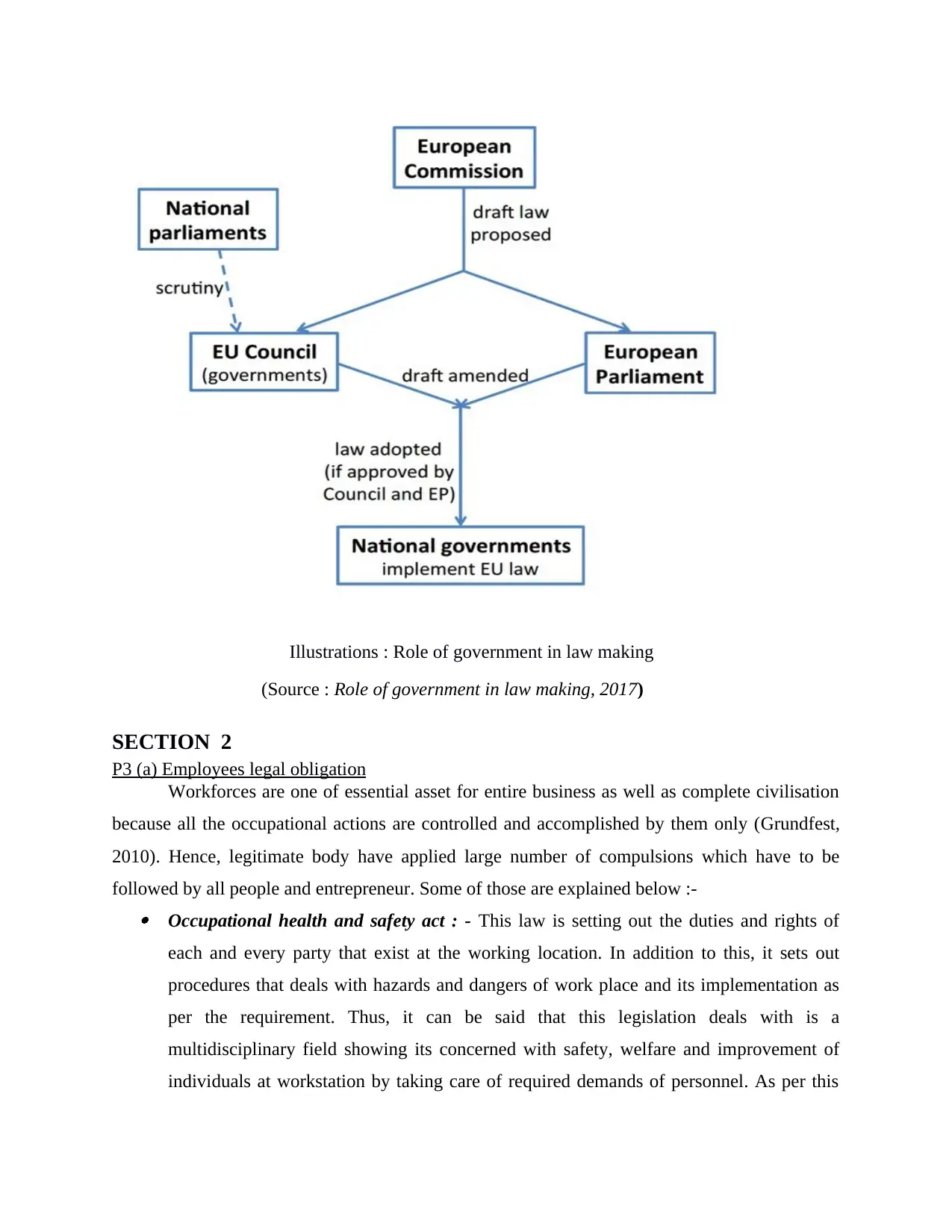
Illustrations : Role of government in law making
(Source : Role of government in law making, 2017)
SECTION 2
P3 (a) Employees legal obligation
Workforces are one of essential asset for entire business as well as complete civilisation
because all the occupational actions are controlled and accomplished by them only (Grundfest,
2010). Hence, legitimate body have applied large number of compulsions which have to be
followed by all people and entrepreneur. Some of those are explained below :- Occupational health and safety act : - This law is setting out the duties and rights of
each and every party that exist at the working location. In addition to this, it sets out
procedures that deals with hazards and dangers of work place and its implementation as
per the requirement. Thus, it can be said that this legislation deals with is a
multidisciplinary field showing its concerned with safety, welfare and improvement of
individuals at workstation by taking care of required demands of personnel. As per this
(Source : Role of government in law making, 2017)
SECTION 2
P3 (a) Employees legal obligation
Workforces are one of essential asset for entire business as well as complete civilisation
because all the occupational actions are controlled and accomplished by them only (Grundfest,
2010). Hence, legitimate body have applied large number of compulsions which have to be
followed by all people and entrepreneur. Some of those are explained below :- Occupational health and safety act : - This law is setting out the duties and rights of
each and every party that exist at the working location. In addition to this, it sets out
procedures that deals with hazards and dangers of work place and its implementation as
per the requirement. Thus, it can be said that this legislation deals with is a
multidisciplinary field showing its concerned with safety, welfare and improvement of
individuals at workstation by taking care of required demands of personnel. As per this
Paraphrase This Document
Need a fresh take? Get an instant paraphrase of this document with our AI Paraphraser
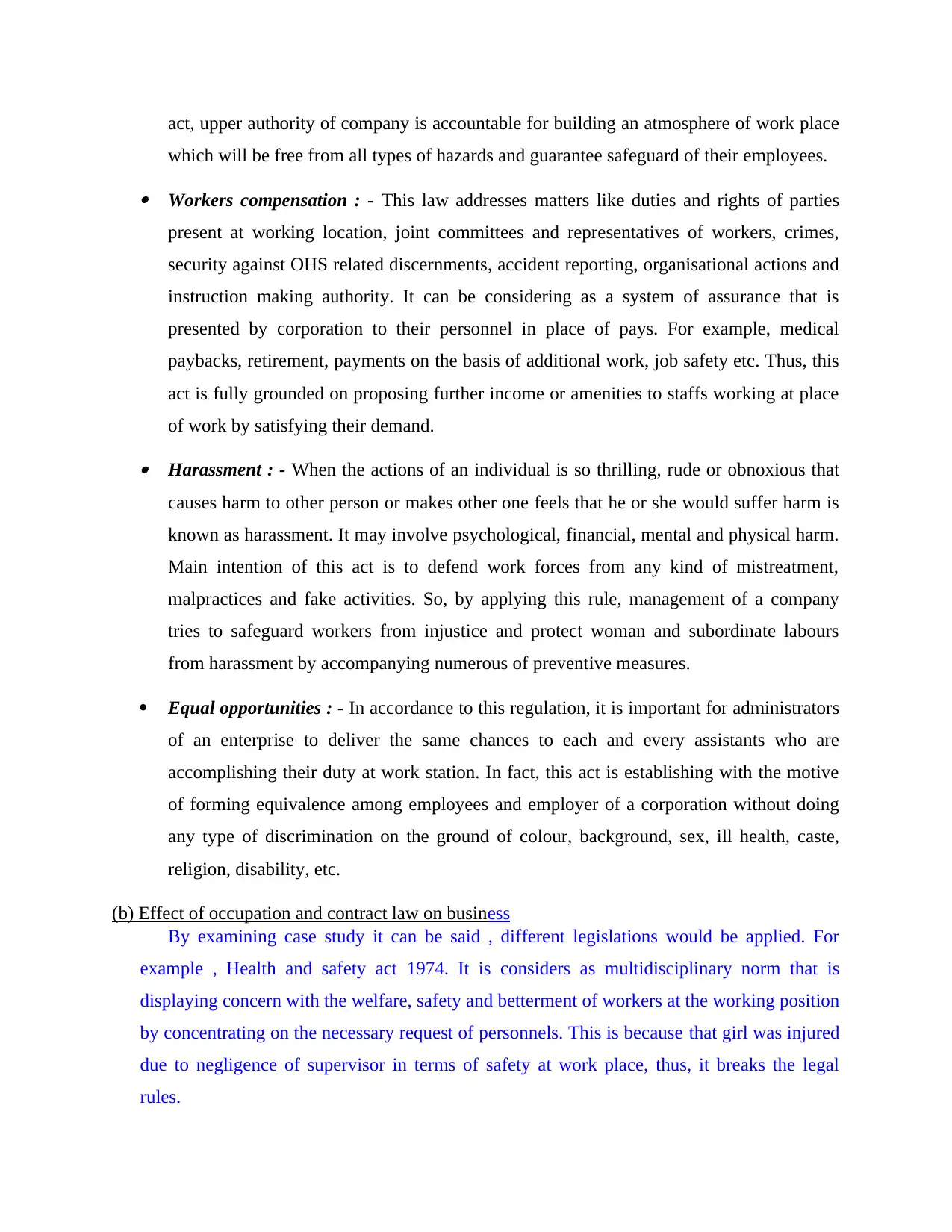
act, upper authority of company is accountable for building an atmosphere of work place
which will be free from all types of hazards and guarantee safeguard of their employees. Workers compensation : - This law addresses matters like duties and rights of parties
present at working location, joint committees and representatives of workers, crimes,
security against OHS related discernments, accident reporting, organisational actions and
instruction making authority. It can be considering as a system of assurance that is
presented by corporation to their personnel in place of pays. For example, medical
paybacks, retirement, payments on the basis of additional work, job safety etc. Thus, this
act is fully grounded on proposing further income or amenities to staffs working at place
of work by satisfying their demand. Harassment : - When the actions of an individual is so thrilling, rude or obnoxious that
causes harm to other person or makes other one feels that he or she would suffer harm is
known as harassment. It may involve psychological, financial, mental and physical harm.
Main intention of this act is to defend work forces from any kind of mistreatment,
malpractices and fake activities. So, by applying this rule, management of a company
tries to safeguard workers from injustice and protect woman and subordinate labours
from harassment by accompanying numerous of preventive measures.
Equal opportunities : - In accordance to this regulation, it is important for administrators
of an enterprise to deliver the same chances to each and every assistants who are
accomplishing their duty at work station. In fact, this act is establishing with the motive
of forming equivalence among employees and employer of a corporation without doing
any type of discrimination on the ground of colour, background, sex, ill health, caste,
religion, disability, etc.
(b) Effect of occupation and contract law on business
By examining case study it can be said , different legislations would be applied. For
example , Health and safety act 1974. It is considers as multidisciplinary norm that is
displaying concern with the welfare, safety and betterment of workers at the working position
by concentrating on the necessary request of personnels. This is because that girl was injured
due to negligence of supervisor in terms of safety at work place, thus, it breaks the legal
rules.
which will be free from all types of hazards and guarantee safeguard of their employees. Workers compensation : - This law addresses matters like duties and rights of parties
present at working location, joint committees and representatives of workers, crimes,
security against OHS related discernments, accident reporting, organisational actions and
instruction making authority. It can be considering as a system of assurance that is
presented by corporation to their personnel in place of pays. For example, medical
paybacks, retirement, payments on the basis of additional work, job safety etc. Thus, this
act is fully grounded on proposing further income or amenities to staffs working at place
of work by satisfying their demand. Harassment : - When the actions of an individual is so thrilling, rude or obnoxious that
causes harm to other person or makes other one feels that he or she would suffer harm is
known as harassment. It may involve psychological, financial, mental and physical harm.
Main intention of this act is to defend work forces from any kind of mistreatment,
malpractices and fake activities. So, by applying this rule, management of a company
tries to safeguard workers from injustice and protect woman and subordinate labours
from harassment by accompanying numerous of preventive measures.
Equal opportunities : - In accordance to this regulation, it is important for administrators
of an enterprise to deliver the same chances to each and every assistants who are
accomplishing their duty at work station. In fact, this act is establishing with the motive
of forming equivalence among employees and employer of a corporation without doing
any type of discrimination on the ground of colour, background, sex, ill health, caste,
religion, disability, etc.
(b) Effect of occupation and contract law on business
By examining case study it can be said , different legislations would be applied. For
example , Health and safety act 1974. It is considers as multidisciplinary norm that is
displaying concern with the welfare, safety and betterment of workers at the working position
by concentrating on the necessary request of personnels. This is because that girl was injured
due to negligence of supervisor in terms of safety at work place, thus, it breaks the legal
rules.
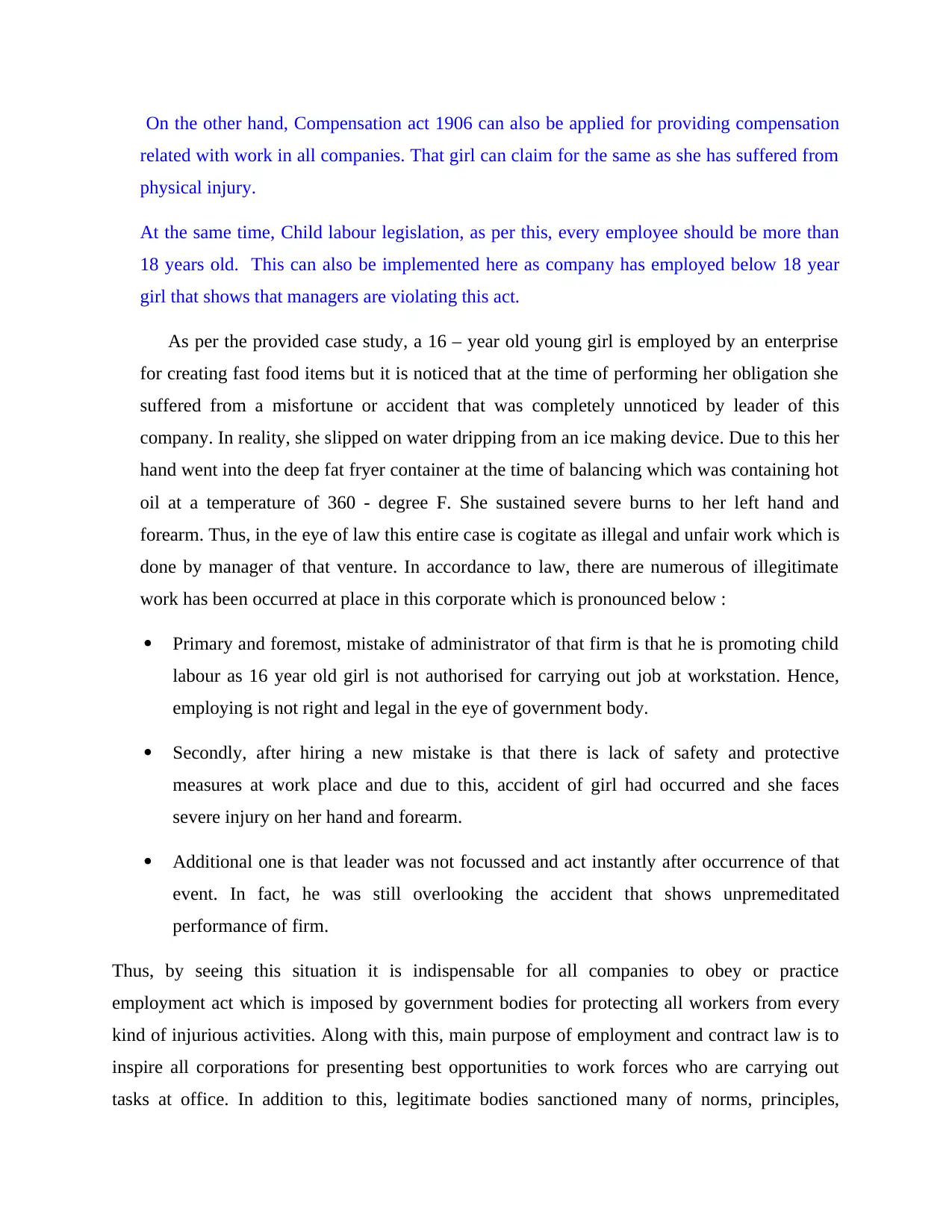
On the other hand, Compensation act 1906 can also be applied for providing compensation
related with work in all companies. That girl can claim for the same as she has suffered from
physical injury.
At the same time, Child labour legislation, as per this, every employee should be more than
18 years old. This can also be implemented here as company has employed below 18 year
girl that shows that managers are violating this act.
As per the provided case study, a 16 – year old young girl is employed by an enterprise
for creating fast food items but it is noticed that at the time of performing her obligation she
suffered from a misfortune or accident that was completely unnoticed by leader of this
company. In reality, she slipped on water dripping from an ice making device. Due to this her
hand went into the deep fat fryer container at the time of balancing which was containing hot
oil at a temperature of 360 - degree F. She sustained severe burns to her left hand and
forearm. Thus, in the eye of law this entire case is cogitate as illegal and unfair work which is
done by manager of that venture. In accordance to law, there are numerous of illegitimate
work has been occurred at place in this corporate which is pronounced below :
Primary and foremost, mistake of administrator of that firm is that he is promoting child
labour as 16 year old girl is not authorised for carrying out job at workstation. Hence,
employing is not right and legal in the eye of government body.
Secondly, after hiring a new mistake is that there is lack of safety and protective
measures at work place and due to this, accident of girl had occurred and she faces
severe injury on her hand and forearm.
Additional one is that leader was not focussed and act instantly after occurrence of that
event. In fact, he was still overlooking the accident that shows unpremeditated
performance of firm.
Thus, by seeing this situation it is indispensable for all companies to obey or practice
employment act which is imposed by government bodies for protecting all workers from every
kind of injurious activities. Along with this, main purpose of employment and contract law is to
inspire all corporations for presenting best opportunities to work forces who are carrying out
tasks at office. In addition to this, legitimate bodies sanctioned many of norms, principles,
related with work in all companies. That girl can claim for the same as she has suffered from
physical injury.
At the same time, Child labour legislation, as per this, every employee should be more than
18 years old. This can also be implemented here as company has employed below 18 year
girl that shows that managers are violating this act.
As per the provided case study, a 16 – year old young girl is employed by an enterprise
for creating fast food items but it is noticed that at the time of performing her obligation she
suffered from a misfortune or accident that was completely unnoticed by leader of this
company. In reality, she slipped on water dripping from an ice making device. Due to this her
hand went into the deep fat fryer container at the time of balancing which was containing hot
oil at a temperature of 360 - degree F. She sustained severe burns to her left hand and
forearm. Thus, in the eye of law this entire case is cogitate as illegal and unfair work which is
done by manager of that venture. In accordance to law, there are numerous of illegitimate
work has been occurred at place in this corporate which is pronounced below :
Primary and foremost, mistake of administrator of that firm is that he is promoting child
labour as 16 year old girl is not authorised for carrying out job at workstation. Hence,
employing is not right and legal in the eye of government body.
Secondly, after hiring a new mistake is that there is lack of safety and protective
measures at work place and due to this, accident of girl had occurred and she faces
severe injury on her hand and forearm.
Additional one is that leader was not focussed and act instantly after occurrence of that
event. In fact, he was still overlooking the accident that shows unpremeditated
performance of firm.
Thus, by seeing this situation it is indispensable for all companies to obey or practice
employment act which is imposed by government bodies for protecting all workers from every
kind of injurious activities. Along with this, main purpose of employment and contract law is to
inspire all corporations for presenting best opportunities to work forces who are carrying out
tasks at office. In addition to this, legitimate bodies sanctioned many of norms, principles,
⊘ This is a preview!⊘
Do you want full access?
Subscribe today to unlock all pages.

Trusted by 1+ million students worldwide
1 out of 20
Related Documents
Your All-in-One AI-Powered Toolkit for Academic Success.
+13062052269
info@desklib.com
Available 24*7 on WhatsApp / Email
![[object Object]](/_next/static/media/star-bottom.7253800d.svg)
Unlock your academic potential
Copyright © 2020–2025 A2Z Services. All Rights Reserved. Developed and managed by ZUCOL.





